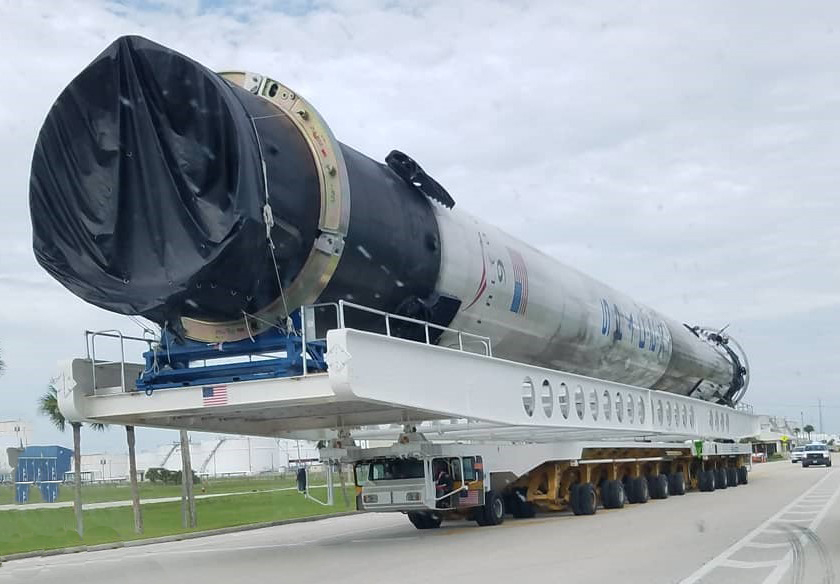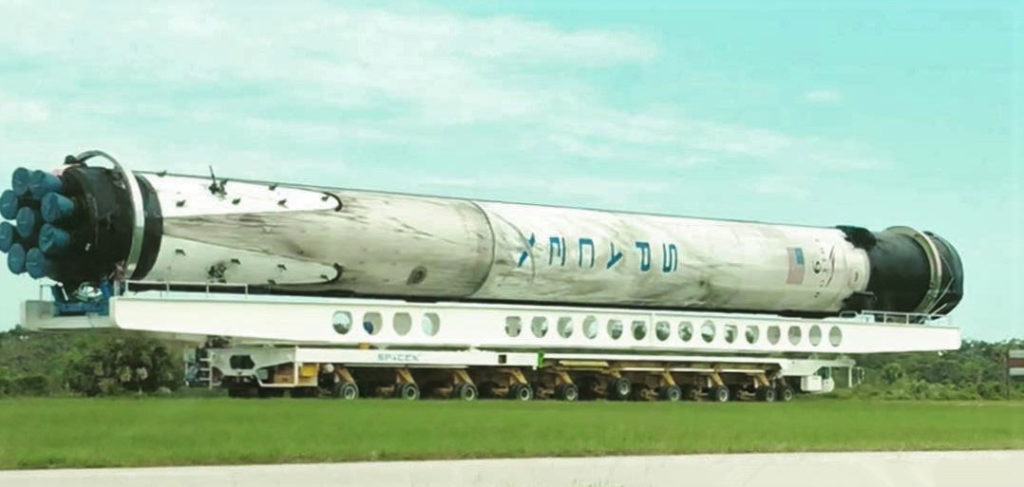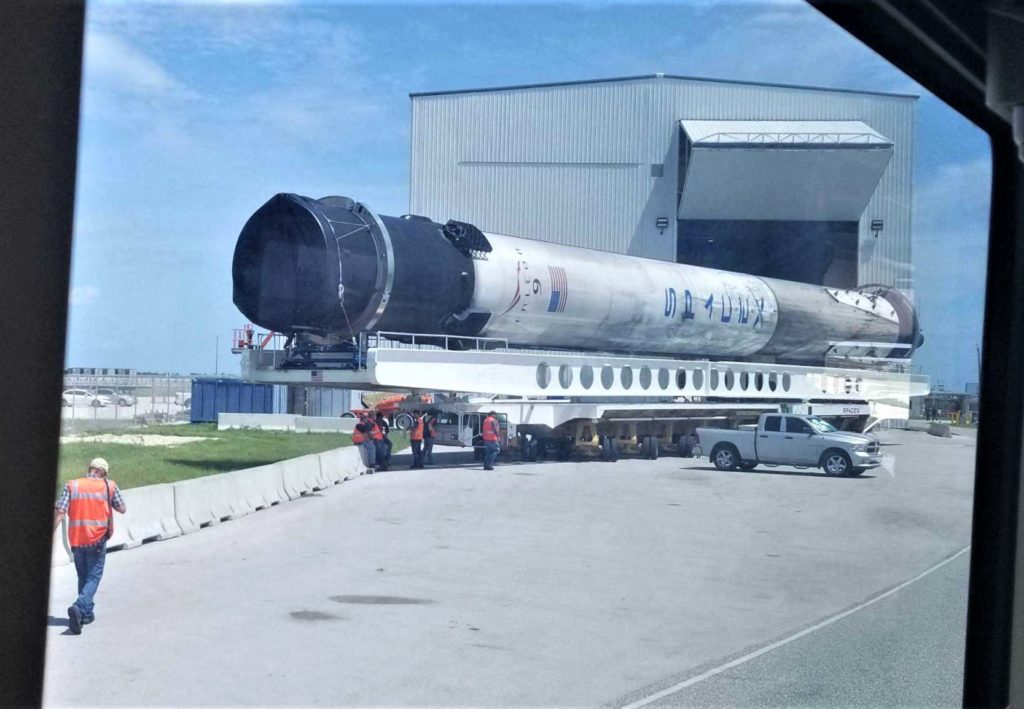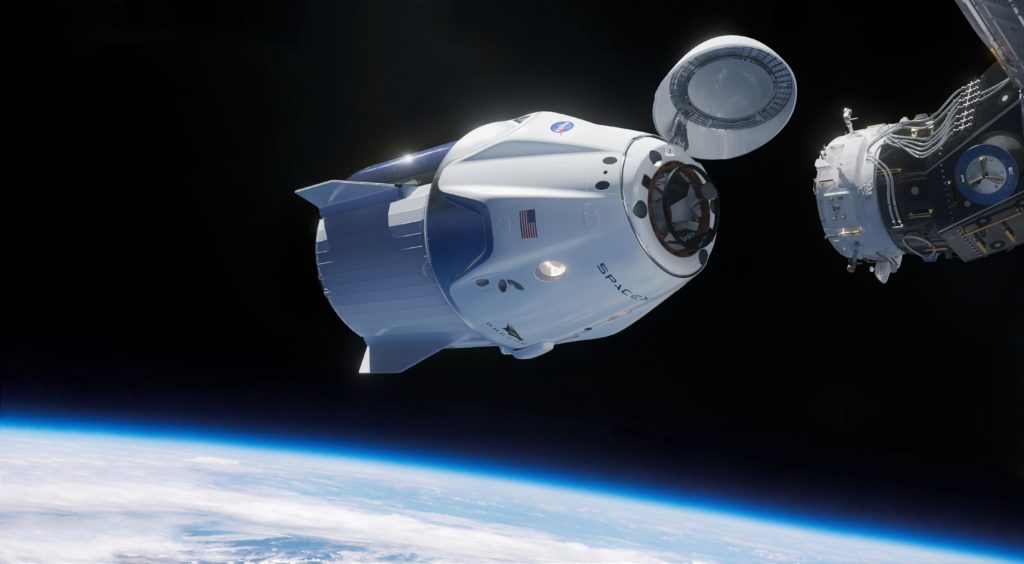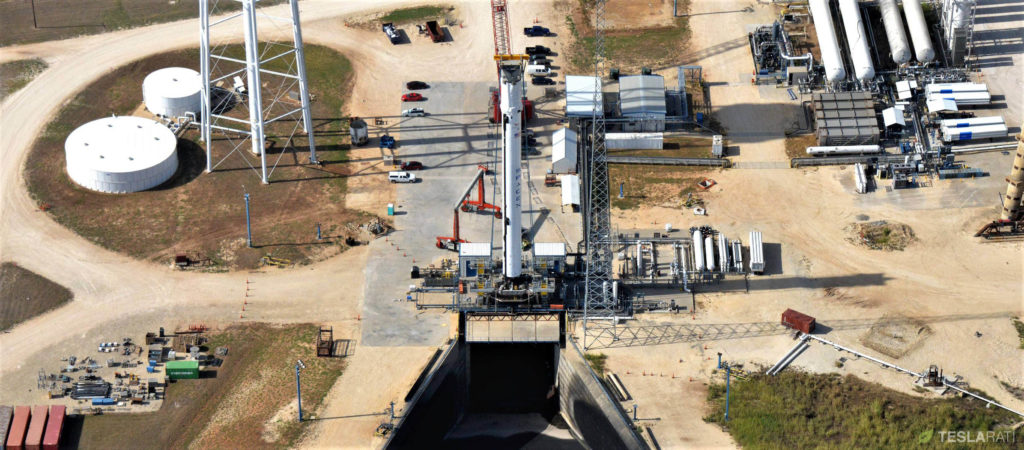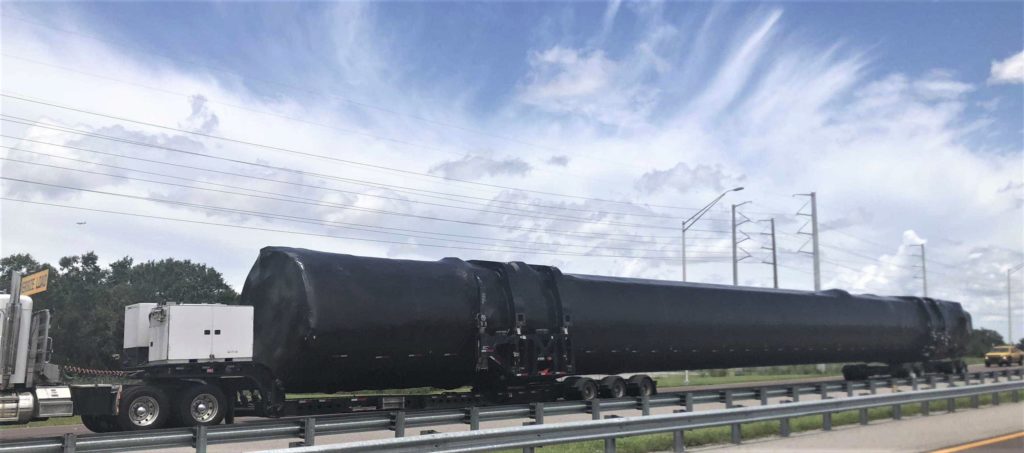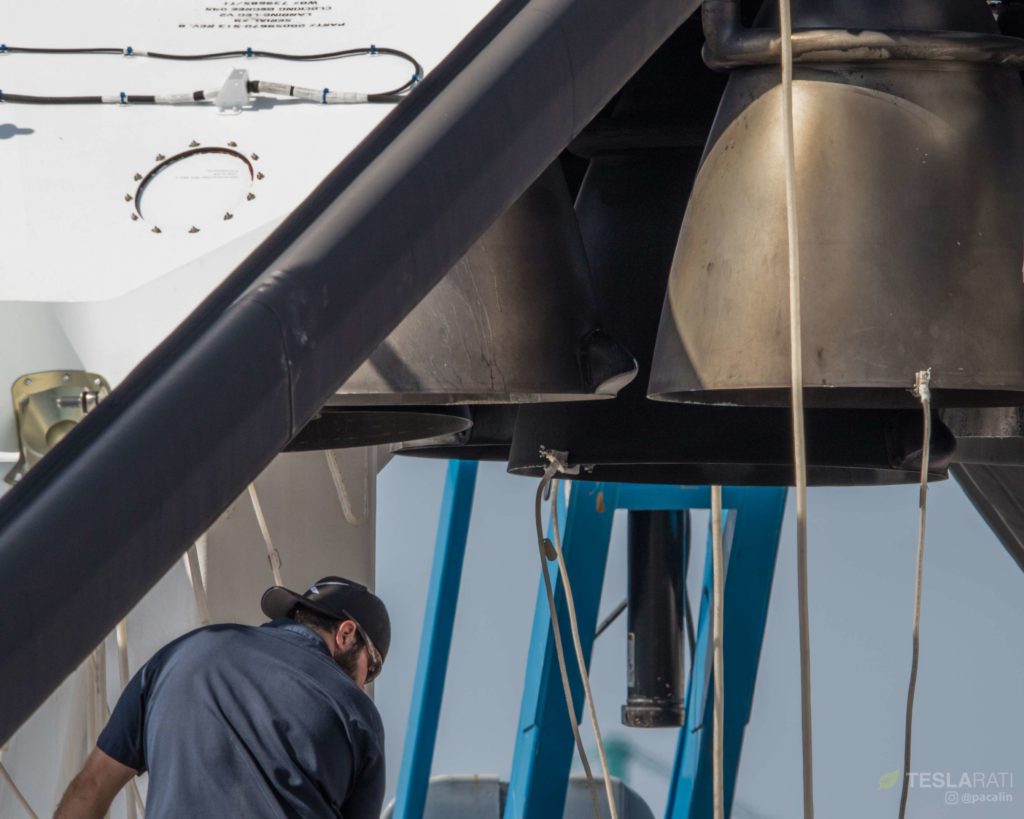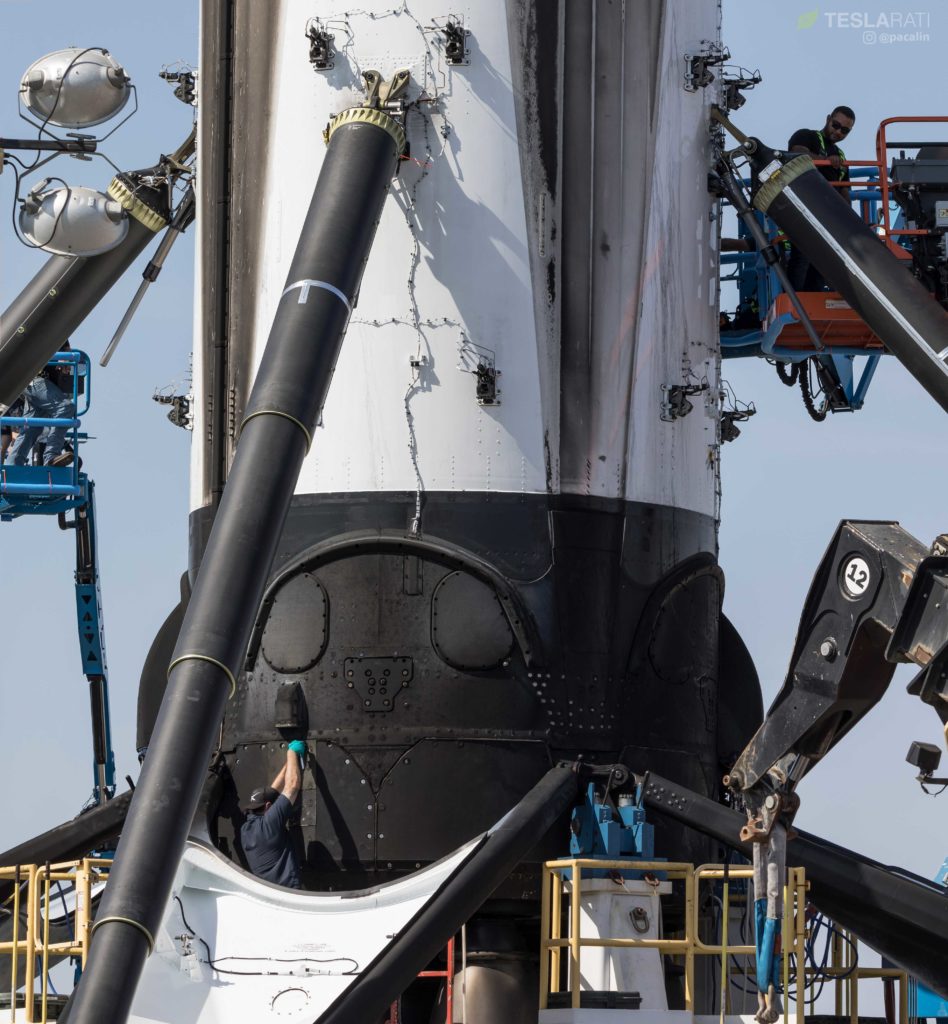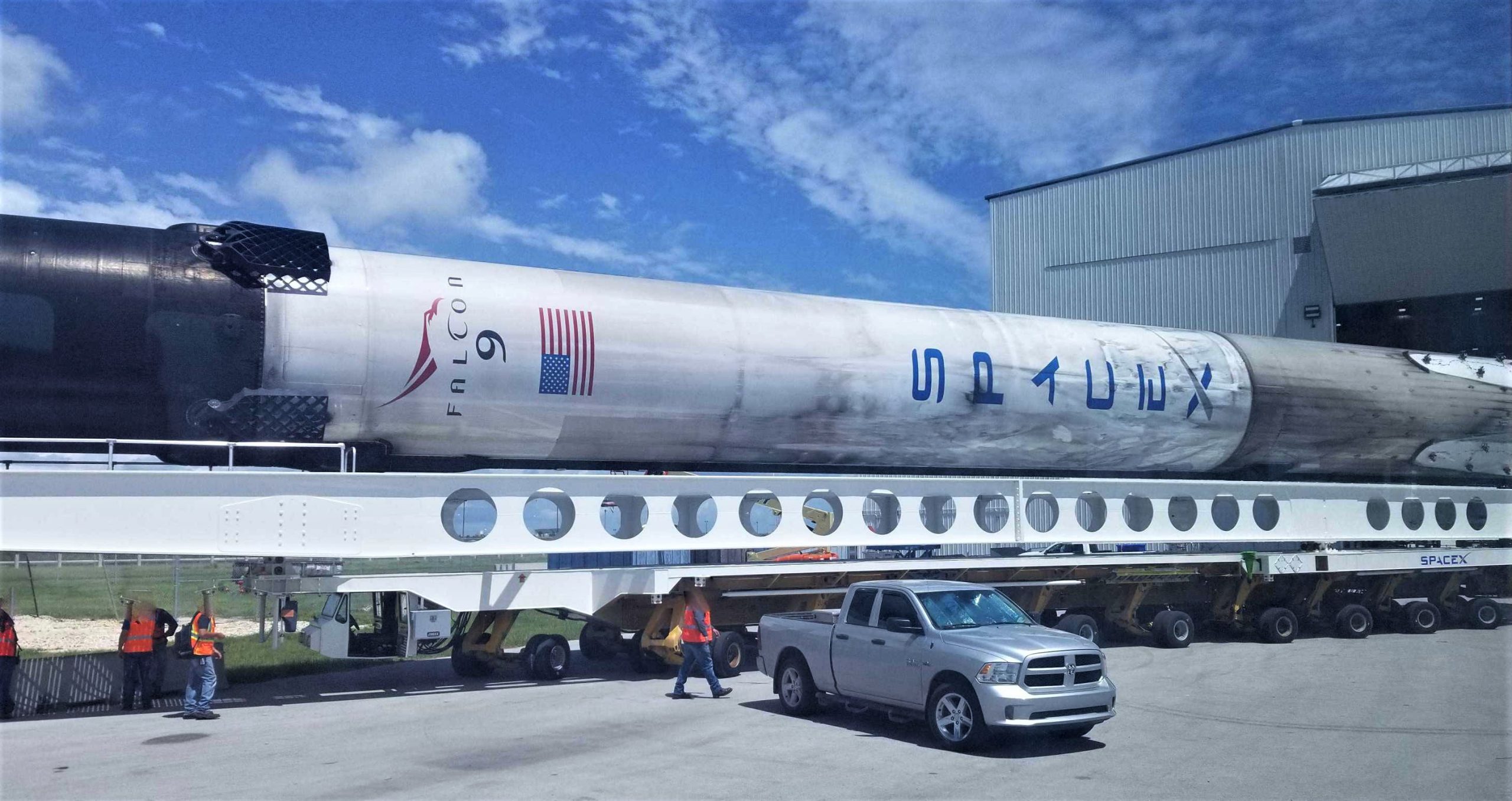
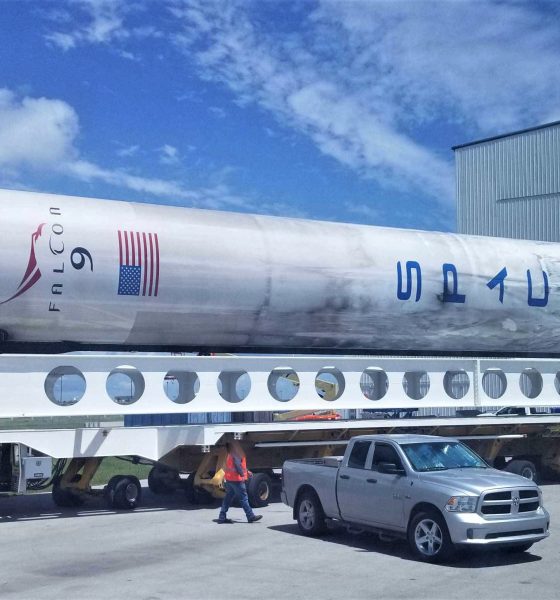
News
SpaceX’s newest Falcon 9 booster arrives in FL as rocket fleet activity rapidly grows
SpaceX’s fifth Falcon 9 Block 5 first stage was spotted a few dozen miles away from arriving at Cape Canaveral at the same time as a freshly launched and landed Block 5 booster was being transported from its drone ship at Port Canaveral to Kennedy Space Center.
The now flight-proven booster in question – B1047 – completed a successful launch of the massive 7100 kg Telstar 19V satellite on July 22nd (EDT), after which it landed safely aboard East Coast drone ship Of Course I Still Love You. Three days after that, sooty Falcon 9 B1047 arrived at Port Canaveral, where it took five days to prepare for transport to one of SpaceX’s several Floridan refurbishment facilities. That transport was captured by an impressive number of independent observers from start to finish, in this case winding up at Pad 39A’s hangar (or horizontal integration facility, HIF) for examination and refurbishment before its next launch.
- B1047 returned safe and sound to Pad 39A for refurbishment less than a week after launching and landing. (Instagram /u/d_lo_ags)
- Likely taken around the same time, Instagram /u/acslater90 took this photo from the opposite direction. (Instagram – acslater90)
- B1047 seen rolling into 39A’s integration hangar for refurbishment on July 31st. (Reddit – Kent767)
Simultaneously, multiple separate members of the subreddit /r/SpaceX observed a different Falcon 9 rocket booster being transported in Western Florida and later Orlando, this time a brand new core shrink-wrapped in the usual black plastic – fresh from static fire testing in McGregor, Texas. A photographer flying in the area in mid-July caught the most likely booster candidate (B1050) vertical on the Texas static fire test stand, rounding out a dizzying array of photos documenting SpaceX’s rigorous test and transport system in action over the last several months.
B1050 will likely be tasked with lifting communications satellite Es’hail-2 in very late August or early September. Intriguingly, the appearance of B1050 in Florida also happens to indicate that SpaceX’s next West Coast launch – SAOCOM 1A, NET September 5th – will have to launch aboard a flight-proven Block 5 booster, of which B1047 and B1048 will be up for consideration. B1051, the next new Block 5 booster expected to ship from Hawthorne to Texas to launch pad, is specifically reserved for SpaceX’s first Crew Dragon mission (DM-1), an uncrewed demo flight that could launch in October or November.
- Crew Dragon gleams in the orbital sunlight before the ISS. The spacecraft’s first launch has reserved Falcon 9 B1051, the next serial booster expected to leave SpaceX’s factory.(SpaceX)
- Falcon 9 B1050 on its way to McGregor for static fire testing, July 6th.
- SpaceX tests all new Falcon 9 boosters and upper stages in Texas before launch. (Aerial Photo/Teslarati)
- Two weeks after it was spotted on the McGregor static fire stand, B1050 rolled into Orlando, FL on July 31st, headed East to Cape Canaveral. (Reddit – alexbrock57)
It’s likely that B1051’s testing and static fire in McGregor will take much longer than the average booster acceptance testing, meaning that the facility’s Falcon 9 booster test capabilities will likely be saturated for a month or longer, pushing B1052’s commercial launch readiness into late September or early October. In reality, B1048 is the only practical option for an early or mid-September launch in California, and that tentative and unofficial booster reflight would crush the current rocket turnaround record by more than four weeks (42 days vs. 72 days).
Booster B1048 just completed its successful debut with the launch of Iridium NEXT-7 and has been under the watchful care of SpaceX recovery technicians since its July 27th return to Port of San Pedro aboard autonomous spaceport drone ship Just Read The Instructions (JRTI). Of particular note, SpaceX technicians took the extraordinary step of opening up B1048’s Merlin engine service bay panels (one per engine along the circumference of the rocket’s base) for several hours on July 30th.
As far as Falcon recoveries go, SpaceX has never been documented performing a similar procedure while the booster is still dockside – perhaps it’s related to the fact that B1050’s East Coast arrival means B1048 will have to be ready for its second launch faster than any SpaceX rocket before it.
- A SpaceX recovery technician works beneath Falcon 9 B1048’s massive octaweb and Merlin 1D engines, July 30. (Pauline Acalin)
- SpaceX technicians examine F9 B1048’s quick-disconnect panel, the interface for much of the vehicle’s fluids and on-pad communications. (Pauline Acalin, 07/30/18)
- A symphony of rocket wrenching, July 30th. (Pauline Acalin)
For prompt updates, on-the-ground perspectives, and unique glimpses of SpaceX’s rocket recovery fleet (including fairing catcher Mr Steven) check out our brand new LaunchPad and LandingZone newsletters!

Elon Musk
Elon Musk’s X will start using a Tesla-like software update strategy
The initiative seems designed to accelerate updates to the social media platform, while maintaining maximum transparency.

Elon Musk’s social media platform X will adopt a Tesla-esque approach to software updates for its algorithm.
The initiative seems designed to accelerate updates to the social media platform, while maintaining maximum transparency.
X’s updates to its updates
As per Musk in a post on X, the social media company will be making a new algorithm to determine what organic and advertising posts are recommended to users. These updates would then be repeated every four weeks.
“We will make the new 𝕏 algorithm, including all code used to determine what organic and advertising posts are recommended to users, open source in 7 days. This will be repeated every 4 weeks, with comprehensive developer notes, to help you understand what changed,” Musk wrote in his post.
The initiative somewhat mirrors Tesla’s over-the-air update model, where vehicle software is regularly refined and pushed to users with detailed release notes. This should allow users to better understand the details of X’s every update and foster a healthy feedback loop for the social media platform.
xAI and X
X, formerly Twitter, has been acquired by Elon Musk’s artificial intelligence startup, xAI last year. Since then, xAI has seen a rapid rise in valuation. Following the company’s the company’s upsized $20 billion Series E funding round, estimates now suggest that xAI is worth tens about $230 to $235 billion. That’s several times larger than Tesla when Elon Musk received his controversial 2018 CEO Performance Award.
As per xAI, the Series E funding round attracted a diverse group of investors, including Valor Equity Partners, Stepstone Group, Fidelity Management & Research Company, Qatar Investment Authority, MGX, and Baron Capital Group, among others. Strategic partners NVIDIA and Cisco Investments also continued support for building the world’s largest GPU clusters.
News
Tesla FSD Supervised wins MotorTrend’s Best Driver Assistance Award
The decision marks a notable reversal for the publication from prior years, with judges citing major real-world improvements that pushed Tesla’s latest FSD software ahead of every competing ADAS system.

Tesla’s Full Self-Driving (Supervised) system has been named the best driver-assistance technology on the market, earning top honors at the 2026 MotorTrend Best Tech Awards.
The decision marks a notable reversal for the publication from prior years, with judges citing major real-world improvements that pushed Tesla’s latest FSD software ahead of every competing ADAS system. And it wasn’t even close.
MotorTrend reverses course
MotorTrend awarded Tesla FSD (Supervised) its 2026 Best Tech Driver Assistance title after extensive testing of the latest v14 software. The publication acknowledged that it had previously criticized earlier versions of FSD for erratic behavior and near-miss incidents, ultimately favoring rivals such as GM’s Super Cruise in earlier evaluations.
According to MotorTrend, the newest iteration of FSD resolved many of those shortcomings. Testers said v14 showed far smoother behavior in complex urban scenarios, including unprotected left turns, traffic circles, emergency vehicles, and dense city streets. While the system still requires constant driver supervision, judges concluded that no other advanced driver-assistance system currently matches its breadth of capability.
Unlike rival systems that rely on combinations of cameras, radar, lidar, and mapped highways, Tesla’s FSD operates using a camera-only approach and is capable of driving on city streets, rural roads, and freeways. MotorTrend stated that pure utility, the ability to handle nearly all road types, ultimately separated FSD from competitors like Ford BlueCruise, GM Super Cruise, and BMW’s Highway Assistant.
High cost and high capability
MotorTrend also addressed FSD’s pricing, which remains significantly higher than rival systems. Tesla currently charges $8,000 for a one-time purchase or $99 per month for a subscription, compared with far lower upfront and subscription costs from other automakers. The publication noted that the premium is justified given FSD’s unmatched scope and continuous software evolution.
Safety remained a central focus of the evaluation. While testers reported collision-free operation over thousands of miles, they noted ongoing concerns around FSD’s configurable driving modes, including options that allow aggressive driving and speeds beyond posted limits. MotorTrend emphasized that, like all Level 2 systems, FSD still depends on a fully attentive human driver at all times.
Despite those caveats, the publication concluded that Tesla’s rapid software progress fundamentally reshaped the competitive landscape. For drivers seeking the most capable hands-on driver-assistance system available today, MotorTrend concluded Tesla FSD (Supervised) now stands alone at the top.
News
Elon Musk’s Grokipedia surges to 5.6M articles, almost 79% of English Wikipedia
The explosive growth marks a major milestone for the AI-powered online encyclopedia, which was launched by Elon Musk’s xAI just months ago.

Elon Musk’s Grokipedia has grown to an impressive 5,615,201 articles as of today, closing in on 79% of the English Wikipedia’s current total of 7,119,376 articles.
The explosive growth marks a major milestone for the AI-powered online encyclopedia, which was launched by Elon Musk’s xAI just months ago. Needless to say, it would only be a matter of time before Grokipedia exceeds English Wikipedia in sheer volume.
Grokipedia’s rapid growth
xAI’s vision for Grokipedia emphasizes neutrality, while Grok’s reasoning capabilities allow for fast drafting and fact-checking. When Elon Musk announced the initiative in late September 2025, he noted that Grokipedia would be an improvement to Wikipedia because it would be designed to avoid bias.
At the time, Musk noted that Grokipedia “is a necessary step towards the xAI goal of understanding the Universe.”
Grokipedia was launched in late October, and while xAI was careful to list it only as Version 0.1 at the time, the online encyclopedia immediately earned praise. Wikipedia co-founder Larry Sanger highlighted the project’s innovative approach, noting how it leverages AI to fill knowledge gaps and enable rapid updates. Netizens also observed how Grokipedia tends to present articles in a more objective manner compared to Wikipedia, which is edited by humans.
Elon Musk’s ambitious plans
With 5,615,201 total articles, Grokipedia has now grown to almost 79% of English Wikipedia’s article base. This is incredibly quick, though Grokipedia remains text-only for now. xAI, for its part, has now updated the online encyclopedia’s iteration to v0.2.
Elon Musk has shared bold ideas for Grokipedia, including sending a record of the entire knowledge base to space as part of xAI’s mission to preserve and expand human understanding. At some point, Musk stated that Grokipedia will be renamed to Encyclopedia Galactica, and it will be sent to the cosmos.
“When Grokipedia is good enough (long way to go), we will change the name to Encyclopedia Galactica. It will be an open source distillation of all knowledge, including audio, images and video. Join xAI to help build the sci-fi version of the Library of Alexandria!” Musk wrote, adding in a later post that “Copies will be etched in stone and sent to the Moon, Mars and beyond. This time, it will not be lost.”
